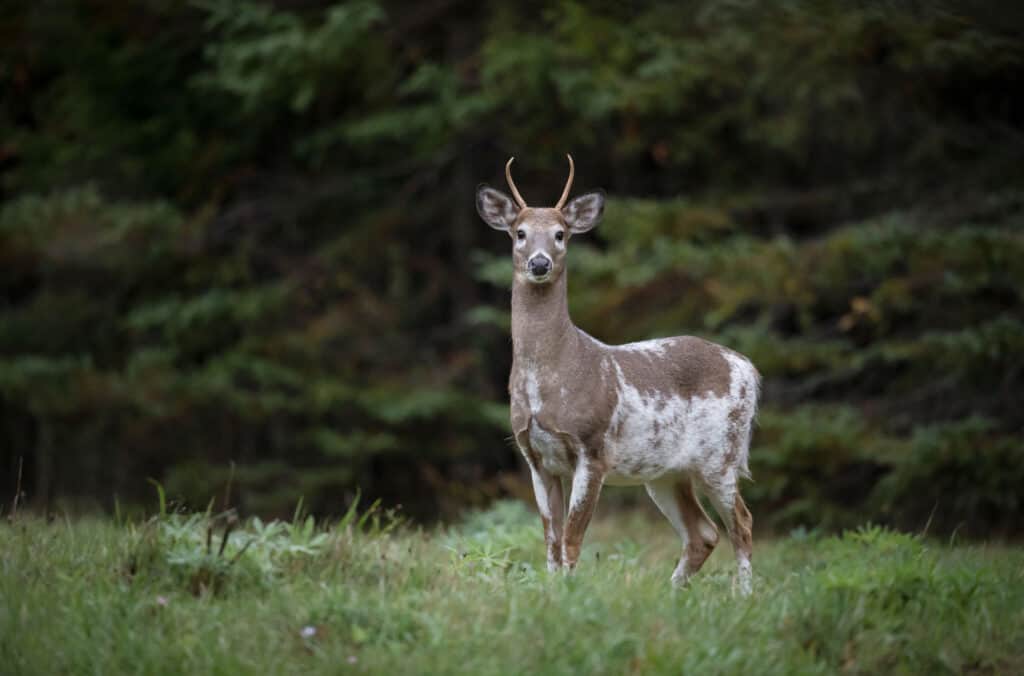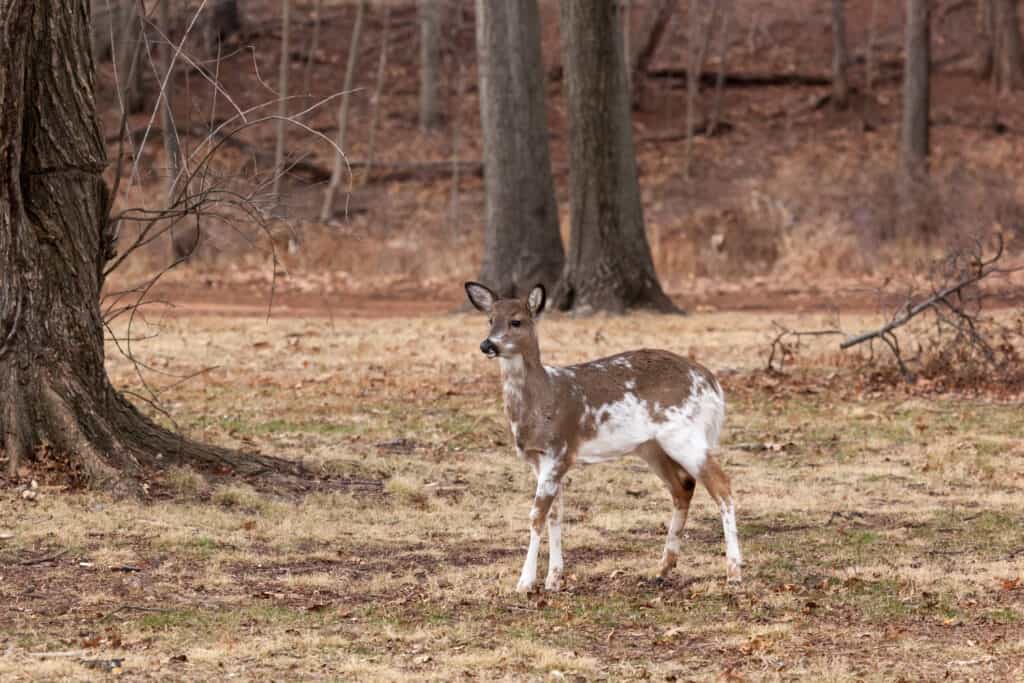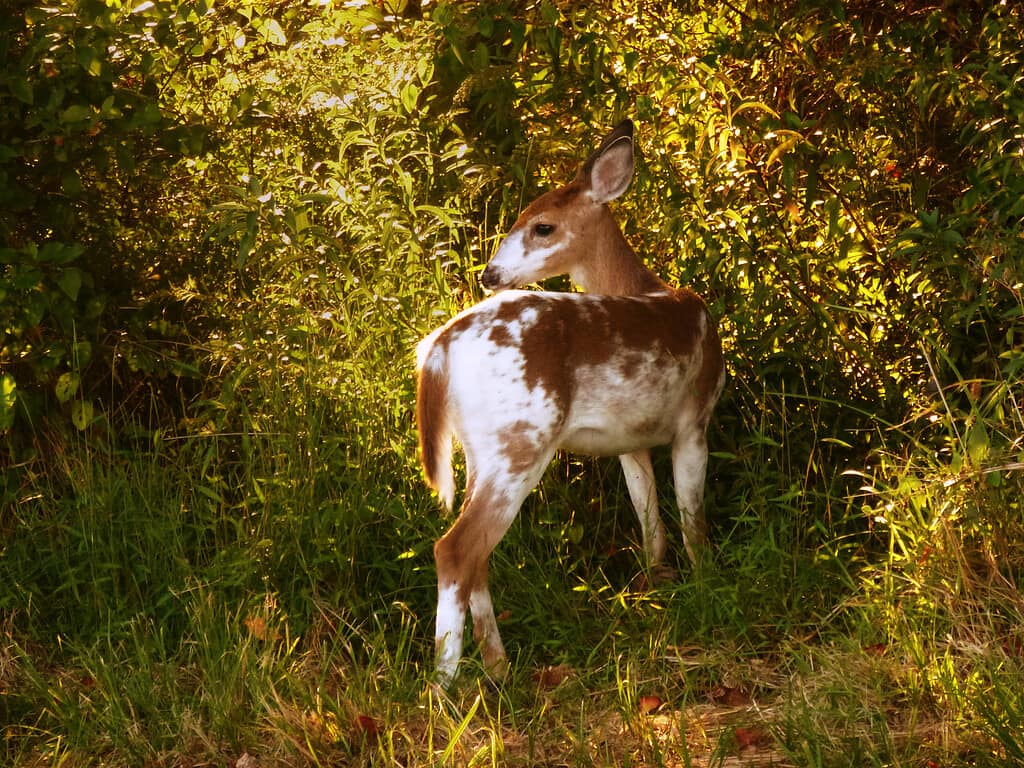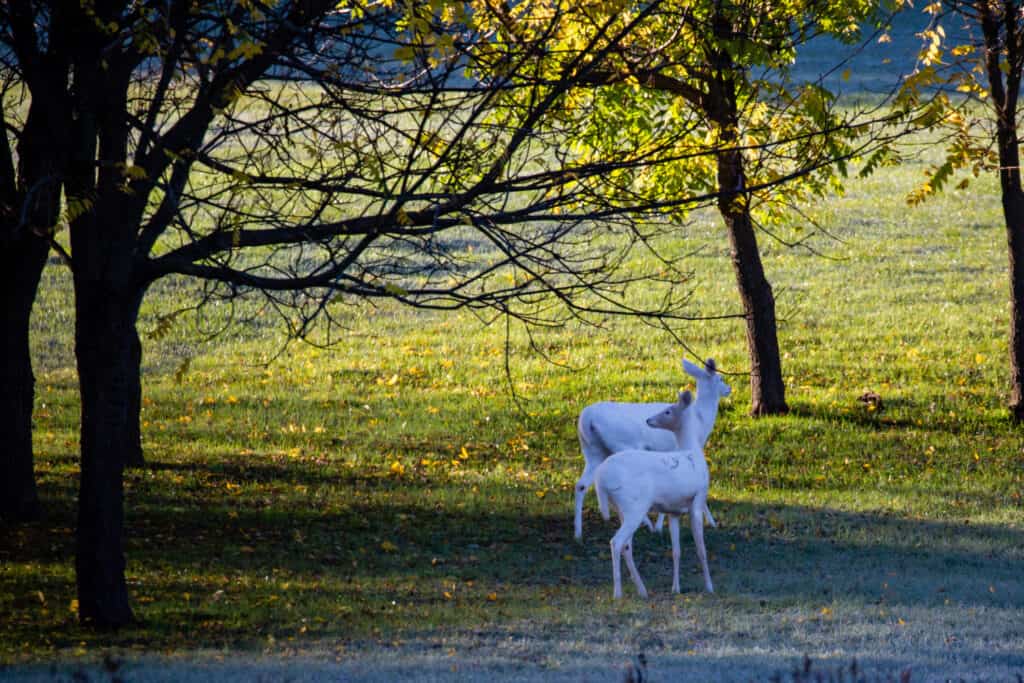Have you ever heard about a type of deer that shouldn’t be hunted and killed because it may curse your future hunting experiences? Well, these rumors are about piebald deer, which we’ll discuss today! Keep reading to learn everything about piebald animals, what piebald deer look like, and what’s with their population’s symbolism!
What Are Piebald Animals?

Piebaldism refers to the absence of melanocytes in specific skin and hair areas.
©Vadim Petrakov/Shutterstock.com
Animals called “piebald” have a pigmented background of hair, scales, or feathers with a unique pattern of white (unpigmented) spots. This condition is called piebaldism and refers to the absence of melanocytes (mature melanin-forming cells) in specific skin and hair areas.
Piebaldism occurs more often than we think. It’s common in almost all mammalian species. Piebald animals include:
- Deer
- Birds
- Cattle
- Cats
- Dogs
- Horses
- Foxes
- Pigs
- Snakes
- Cetaceans
The term “piebald” is a mix between “pie” and “bald,” the former standing for “magpie,” while the latter for “white patch.”
What Are Piebald Deer?

Piebald deer are deer with white spots on a pigmented background.
©iStock.com/Brittany Crossman
As mentioned in the definition above, piebald deer are deer with white spots on a pigmented background. All piebald deer have a unique pattern. Some may be almost completely white with small brown patches. Some may have just a few small white spots.
Piebald deer have brown eyes and noses. Piebaldism in deer may come with short legs, a short lower mandible, an arching spine, internal organ deformities, deformed hooves, or bowing of the nose.
Some deer may be born with several or all of the health issues mentioned above, while others may have none and be completely healthy.
Are Piebald Deer Rare?
Piebald deer are extremely rare. A wildlife research coordinator at the University of Georgia Deer Research Facility, David Osborn, confirmed that studies have shown that the deer population consists of less than 2% of piebald deer! However, if we were to compare them to albino or melanistic deer, piebald deer are the most common!
Even if piebald deer had registered a population growth, this wouldn’t have changed anything, as their color makes them extremely vulnerable in the wild, and many would end up being killed by predators anyway. Because of their unique patterns, predators can easily spot and attack them.
Piebald Deer Symbolism and Myths

Indian tribes considered piebald deer to be embodiments of spirits passing to or from the spirit world.
©iStock.com/luvemakphoto
Would you believe us if we told you that legend has it that killing a piebald deer brings bad luck during future hunts or even curses the hunter? Superstitious hunters believe that only seeing a deer means they’ll have a bad hunting experience, and some will even give up on hunting for the moment. People in some parts of Europe even believe those who kill a piebald deer will die within a year.
However, contrary to hunting symbolism, Indian cultures saw piebald deer from a completely different perspective. Indian tribes considered piebald deer to be embodiments of spirits passing to or from the spirit world. Seeing a piebald deer meant that change was coming. The Indian population carried profound respect for the piebald deer population, and killing one was prohibited. Research says that piebald deer are still alive thanks to Indian tribes’ preservation efforts.
What Are the Problems with Piebald Deer?

Piebald Deer are known to have health issues early in life due to their skin pigmentation.
©Bob Didner/iStock via Getty Images
Apart from their unique coloration, piebald deer may also experience problems related to their bone development. Instances have been documented where these deer have faced issues such as bent spines, shorter or misshapen limbs, curvature of the nose, abnormalities in internal organs, and shortened jaws.
Further, Piebald deer exhibit various congenital problems that increase their vulnerability during their early life stages.
These issues often include pronounced overbites, irregularities in limb and foot development, spinal scoliosis, and internal organ abnormalities.
It’s important to note that the color abnormalities in albino deer are solely linked to the absence of pigmentation in their hair and skin.
Piebald Deer vs. Melanistic Deer
Melanism and piebaldism are different disorders. While piebald deer have a white-brown coat pattern, melanistic deer have dark hair, sometimes black. This happens due to a genetic mutation that causes pigment overproduction. Compared to piebald deer, melanistic deer’s dark hair gives them a huge advantage in hiding from predators.
Piebald Deer vs. Albino Deer

Albino deer have pink or red eyes.
©iStock.com/Michael-Tatman
As already mentioned, piebald deer have brown hair and white spots. Albino deer, however, are completely white. They are extremely rare, much rarer than piebald deer. Moreover, while piebald deer have regular brown eyes, albino deer have pink or red eyes and may have poor eyesight. They are even more vulnerable to hunting and predation.
Should You Shoot a Piebald Deer?
If you believe in superstitions, then, of course, we do not recommend shooting piebald deer! Other than that, there shouldn’t be any issues if you shoot a piebald deer as long as you know they aren’t protected in the area you’re hunting.
We recommend checking this beforehand since piebald deer are protected in many regions nowadays. For example, up until a few years ago, Oklahoma asked for written permission signed by the state wildlife director to shoot a piebald deer. Moreover, shooting white or predominantly white deer in Iowa is illegal.
Some believe that shooting piebald deer does the deer population a favor. Why? Because piebaldism comes with several health issues, reducing their population may limit the spread. However, David Osborn, the research coordinator we’ve mentioned, confirmed that killing them has little to no effect on reducing piebaldism, as hidden genes will continue to spread.
Other Types of Rare Deer
If you’re a deer enthusiast, you’ll probably want to learn about other rare types of deer. Here are some of them:
- Visayan spotted deer – it is one of the smallest deer species in the world. Nowadays, there are only around 300 Visayan spotted deer in the world, and all are taken care of by humans; the IUCN lists this species as Endangered, and it’s considered one of the world’s rarest deer species;
- Key deer – this deer species lives only in the Florida Keys; it has a reddish-brown coat and likes being around people; there are only roughly 800 key deer left in the wild;
- Little red brocket – it’s a tiny brocket deer species that has a white underbelly and an overall reddish coat; it is nocturnal and lives in South America’s Andes region; the IUCN lists this species as Vulnerable;
- Northern pudu – the smallest deer species that weighs around 15 pounds and has small antlers; it lives primarily in South America’s rainforests;
- Chinese water deer – this deer species is often called “vampire deer” because of the canine tusks; only about 10,000 Chinese water deer specimens are left in the wild.
Thank you for reading! Have some feedback for us? Contact the AZ Animals editorial team.







